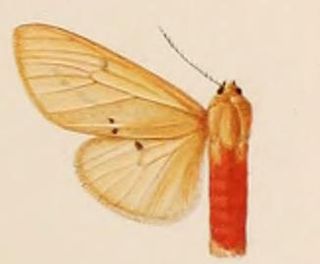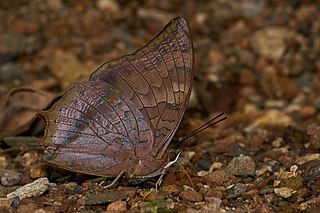Related Research Articles

Nymphalis xanthomelas, the scarce tortoiseshell, is a species of nymphalid butterfly found in eastern Europe and Asia. This butterfly is also referred as yellow-legged tortoiseshell or large tortoiseshell.

Grammodes geometrica is a moth found from the Mediterranean east to Oriental and Australasian tropics of India, Sri Lanka, Java and Australia. The adult is a fruit piercer. The species was first described by Johan Christian Fabricius in 1775.

Conistra rubiginea is a moth of the family Noctuidae. It is distributed in Europe and according to Warren Armenia and Asia Minor.

Mythimna conigera, the brown-line bright-eye, is a moth of the family Noctuidae.

Thyas coronata is a species of moth of the family Noctuidae first described by Johan Christian Fabricius in 1775. It is found from the Indo-Australian tropics of southern China, Taiwan, Japan, Nepal, India, Sri Lanka to Micronesia and the Society Islands.

Spilosoma semperi is a moth of the family Erebidae. It was described by Walter Rothschild in 1910. It is found on Sumatra and Peninsular Malaysia.
Spilosoma fraterna is a moth of the family Erebidae first described by Walter Rothschild in 1910. It is found on Papua New Guinea.
Blepharomastix fusalis is a moth in the family Crambidae. It was described by George Hampson in 1917. It is found in Colombia.
Patania hemipolialis is a moth in the family Crambidae. It was described by George Hampson in 1918. It is found in Colombia.
Polygrammodes atricosta is a moth in the family Crambidae. It was described by George Hampson in 1913. It is found on Ambon Island in Indonesia.
Polygrammodes sanguifrons is a moth in the family Crambidae. It was described by George Hampson in 1913. It is found in Peru.
Sameodes furvipicta is a moth in the family Crambidae. It is found in Papua New Guinea.
Spilomela divaricata is a moth in the family Crambidae. It is found in Brazil.
Syllepte methyalinalis is a moth in the family Crambidae. It was described by George Hampson in 1912. It is found in Guyana.
Syllepte tetrathyralis is a moth in the family Crambidae. It was described by George Hampson in 1912. It is found in New Guinea.
Syngamia albiceps is a moth in the family Crambidae. It was described by George Hampson in 1912. It is found in Singapore.
Udeoides nigribasalis is a moth in the family Crambidae. It was described by George Hampson in 1913. It is found in Kenya.
Ambia fulvicolor is a moth in the family Crambidae. It was described by George Hampson in 1917 and it is found in New Guinea.

Nordstromia bicostata is a moth in the family Drepanidae. It was described by George Hampson in 1912. It is found in Sikkim in India, Sichuan in China, Nepal and northern Myanmar.

Charaxes psaphon, plain tawny rajah, is a butterfly in the family Nymphalidae. It was described by John Obadiah Westwood in 1847. It is found in the Indomalayan realm.
References
- ↑ Nuss, M.; et al. (2003–2014). "GlobIZ search". Global Information System on Pyraloidea. Retrieved 2014-07-15.
- ↑ The Annals and Magazine of Natural History: Including Zoology, Botany, and Geology
| This Pilocrocis-related article is a stub. You can help Wikipedia by expanding it. |